Building In Plywood
Build Your Own Boat using Construction Methods and plans from Hartley Boat Plans.
Plywood is the most popular method of amateur boat construction. For the double layer plywood construction method of round bilge boats, see the Westhaven 32 sailboat.
Material costs are moderate except for some of the hard woods. Modern plywoods using epoxy glued laminates and the use of epoxy sealer systems has extended the life of plywood craft well beyond GRP/FRP. Hartley plywood designs with our easy construction methods and full size frame patterns, enable a professional styled craft to be finished to professional standards by amateurs. Small or large boats, they are all the same, only the time and cost factor varies. Construction must be undertaken under cover.
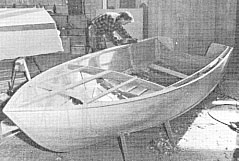
Hartley boats are built in six basic stages. 1/ make the strongback (building frame), as the base for building the boat on. 2/ make the frames, stem and rim pieces using the full size frame patterns. 3/set all up on the building frame as shown and attach stringers, sheer etc. 4/attach the plywood sheeting. 5/ finish and attach further fittings etc (any deck and cabin tops in the same manner with beams made using full size patterns provided). 6/ fit out, prepare and paint.
Plywood is easy for the amateur to repair when damaged.
Building In Wood
For amateur construction a wooden framework when combined with plywood sheet or strip covering is a relativel simple process….however wood planking a hull is not within the realms of the average amateur.
The process is difficult without tuition or previous experience and mistakes can be costly. Material costs are high as well as the almost impossible task of finding suitable cured material.
The traditional materials required for this traditional method of construction, are in general terms almost unobtainable.

Building In Ferro-cement
Often referred to as ‘concrete’, which is a misnomer, in reality it is steel reinforced plaster (SRP). Introduced more than 200 years ago for boatbuilding (there are still surviving craft almost that age). The cheapest and easiest form of construction for boats over 25′. No previous experience is required. Can be built outside without cover.
The world renowned Hartley web-frame construction method superior for strength and ease of fitting out (is copied by many). Mistakes and damage are easily repaired. Lowest level of on-going maintenance. No specialist tools required.
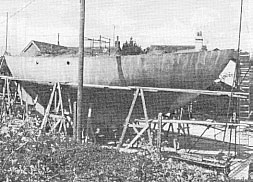
Apart from strip plank construction it is the only viable method for building large round-bilge boats economicaly within amateur capability.
It is estimated that more than 80% of all amateur owner built monohull boats that have made extended ocean voyages, are of ferro-cement construction.
Contact us for more information on ferro boat building.
Building In Steel
If you can already weld, building a Hartley boat in steel is easy.
All steel boats, or ply suggested as suitable for steel in our catalogue can be built with either 140 amp home stick welder or equivalent gas, mig or tig welders.
No specialised rolling or forming equipment is required. With modern paints and preparations rusting can be cut back considerably.
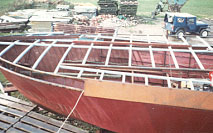
Building In Aluminium
A good construction medium for building light craft. Method of construction is the same as for building in steel. Skill and experience of working with aluminium is a necessity.
Material costs vary considerably from country to country, but usually fit somewhere between plywood and G.R.P.(generally the highest). Extreme care is needed with the application of protective etching primers and paints, in order to prolong the life of aluminium craft. Construction under cover is an important consideration. Most Hartley plywood or steel designs can be built in aluminium.
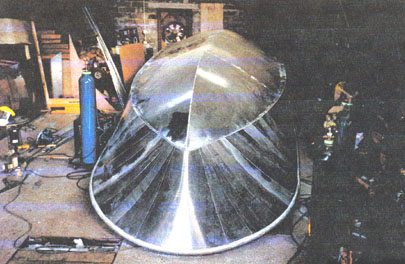
Building In Fibreglass – grp/frp
Glass or fibre re-inforced plastic, often referred to as ‘glass fibre construction’, is the method preferred by most professionals. Once a mould has been made, it is relatively easy to form hulls from it time and time again. Unfortunately this is not the scenario for the amateur building his ‘one-off’. Material costs in many countries are high and mistakes can be costly. Very difficult for the amateur to repair (sometimes impossible). A temperature and humidity controlled building is often a necessity.
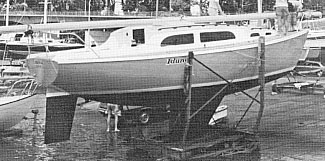
Building In Wood Strip-plank
A good method for amateur construction of round bilge hulls in wood. Our ferro-cement designs can easily be adapted to strip-plank construction. The hull is formed by using thin strips of approx 1″ thickness, which are then glued and edge nailed to each other to skin the hull. Material costs are not prohibitive, although hardwood is used it can be machined from short or off-cut lengths. The framework of the hull can either be made of wood, laminated plywood, or fabricated from steel or aluminium, of either angle or strip. The latter known as composite strip-plank construction.

Stitch and Glue Method of Boat Construction
The stitch and glue method was introduced for twofold reasons:
(a) So that designs could be simpler and drawn without the need of a background of either basic boatbuilding or drafting skills.
(b) To save time on building, and eliminate some of the care needed in making wood joints, as well as remove the necessity for some of the metal fastenings. The process was however found to be only suitable short term for very small craft.
The introduction of epoxy glue with it’s ease of use ‘stronger than wood’ and gap-filling properties has generally made stitch & glue redundant.

